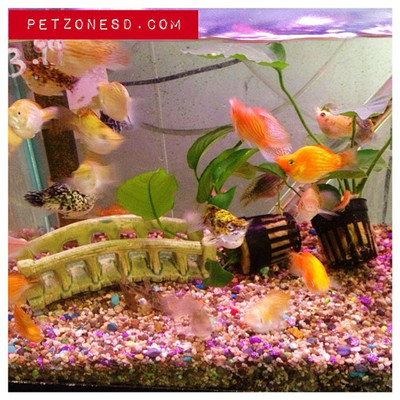Balloon Molly (Poecilia latipinna variant)
Posted by Max Gandara on on 21st May 2025
Balloon Molly (Poecilia latipinna variant) – A Unique Twist on a Classic Livebearer
With their adorably round bellies, waddling swim style, and vibrant colors, Balloon Mollies are one of the most distinctive and popular livebearers in the freshwater hobby. While their appearance may divide opinions, their charm, peaceful nature, and hardiness have won the hearts of aquarists around the world.
? What Is a Balloon Molly?
The Balloon Molly is a selectively bred variant of the Shortfin Molly (Poecilia latipinna) or Sailfin Molly (Poecilia velifera), known for its arched back and rounded, balloon-like belly. This unique body shape is the result of genetic modification—selectively bred for curvature and size.
Though controversial among some aquarists for ethical reasons due to their altered spine, Balloon Mollies are generally healthy when bred responsibly and kept in proper conditions.
? Colors & Varieties
Balloon Mollies come in a wide range of colors and patterns, including:
-
Black
-
Gold Dust
-
Dalmatian (black and white speckled)
-
Marble
-
Orange, Yellow, or Silver
-
Lyretail Balloon Mollies (featuring a forked tail)
? Size & Lifespan
-
Adult Size: 2–3 inches (5–7.5 cm)
-
Lifespan: 3–5 years
-
Sexual Dimorphism: Males have a gonopodium (modified anal fin); females are larger and more rounded
? Tank Requirements
Balloon Mollies are adaptable but thrive in stable, slightly alkaline, and well-maintained aquariums.
Ideal Conditions:
-
Tank Size: 20 gallons minimum (larger for groups)
-
Temperature: 24–28°C (75–82°F)
-
pH: 7.5–8.5
-
Water Hardness: Moderate to hard
-
Salinity: Can tolerate and even benefit from low salinity (brackish conditions)
They love well-planted tanks with open swimming areas and gentle filtration. A sandy or fine gravel substrate is ideal.
? Behavior & Tankmates
Balloon Mollies are peaceful, social fish that do best in groups of at least 3–5. They’re active, often seen grazing on algae or swimming together in loosely formed schools.
Good Tankmates Include:
-
Guppies
-
Platies
-
Swordtails
-
Corydoras
-
Peaceful tetras
-
Snails and shrimp (in well-planted tanks)
Avoid aggressive or fin-nipping species that may bully their slower-moving balloon-shaped bodies.
? Diet & Feeding
Balloon Mollies are omnivores with a big appetite. A varied diet keeps them colorful, active, and healthy.
Recommended Diet:
-
High-quality flakes or micro pellets
-
Algae wafers (they love grazing)
-
Blanched vegetables (zucchini, spinach, cucumber)
-
Frozen or live foods (brine shrimp, daphnia, bloodworms)
Feed once or twice daily in small portions to avoid overfeeding and water quality issues.
? Breeding Balloon Mollies
Like other mollies, Balloon Mollies are livebearers and breed easily in home aquariums.
Breeding Notes:
-
Females can give birth to 20–50 fry every 4–6 weeks
-
Provide hiding places (plants or breeding boxes) for fry survival
-
Separate adults if you plan to raise fry—they may eat their young
-
Fry can be fed crushed flakes or baby brine shrimp
Tip: Since they breed readily, consider population control if you're not raising fry.
⚠️ Special Considerations
-
Genetic deformity: The balloon shape is a spinal curvature, not a bloated belly
-
Swimming: They swim slower and less efficiently than standard mollies
-
Health: Prone to swim bladder issues and constipation—feed fibrous foods and avoid overfeeding
-
Water quality: Sensitive to poor conditions—ensure regular water changes and good filtration
❤️ Final Thoughts
Whether you’re drawn to their unusual shape or their friendly demeanor, Balloon Mollies offer a unique and colorful addition to community tanks. They’re easy to care for, fun to watch, and available in a rainbow of patterns—ideal for beginner and experienced aquarists alike.
While it's important to be mindful of their breeding origins and care requirements, a well-kept group of Balloon Mollies can thrive and bring life and charm to your aquarium.
Do you keep Balloon Mollies? Share your favorite variety or care tips below—we’d love to hear about your experience!

